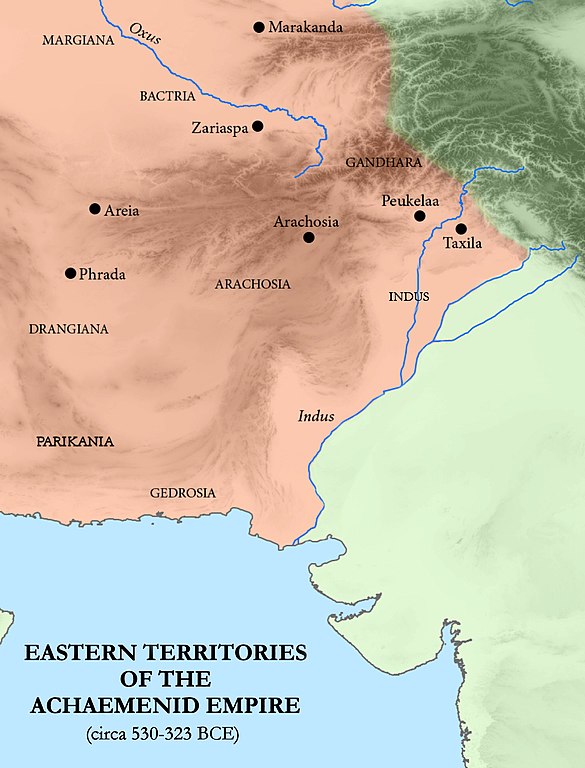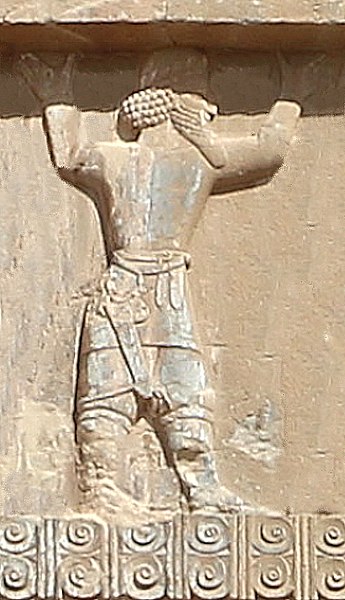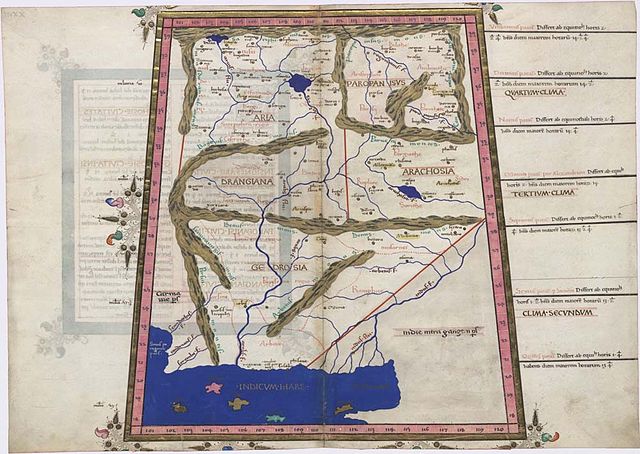ARIA
REGION

Eastern
territories of the Achaemenid Empire, including Aria (around the
city of Areia)

Arian
soldier, on a relief of the tomb of Artaxerxes III (circa 338 BCE)
Aria
(Latin Aria, representing Old Persian. Haraiva, Avestan Haraeuua)
is an Achaemenid region centered on the city of Herat in present-day
western Afghanistan. In classical sources, Aria has been several
times confused with the greater region of ancient Ariana, of which
Aria formed a part.
Geography
:
Aria was an Old Persian satrapy, which enclosed chiefly the valley
of the Hari River (this being eponymous to the whole land according
to Arrian) and which in antiquity was considered as particularly
fertile and, above all, rich in wine. The region of Aria was separated
by mountain ranges from the Paropamisadae in the east, Parthia in
the west and Margiana and Hyrcania in the north, while a desert
separated it from Carmania and Drangiana in the south. It is described
in a very detailed manner by Ptolemy and Strabo and corresponds,
according to that, almost to the Herat Province of today's Afghanistan.
In this sense the term is used correctly by some writers, e.g. Herodotus
(3.93.3, where the Areioi are mentioned together with the Parthians,
Chorasmians, and Sogdians); Diodorus (17.105.7; 18.39.6); Strabo
(2.1.14; 11.10.1, cf. also 11.8.1 and 8; 15.2.8 and 9); Arrian (Anabasis
3.25.1); Pomponius Mela (1.12, where we read that “nearest
to India is Ariane, then Aria”).

Reconstruction of Ptolemy's map (2nd century AD) of Aria
and neighbouring states by the 15th century German cartographer
Nicolaus Germanus
Its original capital was Artacoana or Articaudna according to Ptolemy.
In its vicinity, a new capital was built, either by Alexander the
Great himself or by his successors, Alexandria Ariana, modern Herat
in northwest Afghanistan. Ptolemy lists several other cities, an
indication of the province's wealth and fertility. The most important,
according to Ptolemy and Arrian were :
•
Dista
• Nabaris
• Taua
• Augara
• Bitaxa
• Sarmagana
• Sipharê
• Rhagaura
• Zamuchana
• Ambrodax
• Bogadia
• Varpna
• Godana
• Phoraga
• Chatrisachê
• Chauvrina
• Orthiana
• Taupana
• Astanda
• Articaudna
• Alexandria
in Aria
• Babarsana
• Caputana
• Susia
• Aria
civitas
• Basica
• Sotira
• Orbetanê
• Nisibis
• Paracanacê
• Gariga
• Darcama
• Cotacê
• Tribasina
• Astasana
• Zimyra
History :
The Persian Achaemenid district of Aria is mentioned in the provincial
lists that are included in various royal inscriptions, for instance,
in the Behistun inscription of Darius I (c. 520 BC). Representatives
from the district are depicted in reliefs, e.g., at the royal Achaemenid
tombs of Naqsh-e Rustam and Persepolis. They are wearing Scythian-style
dress (with a tunic and trousers tucked into high boots) and a twisted
turban around the head.
At
the time of Alexander the Great, Aria was obviously an important
district. It was administered by a satrap, called Satibarzanes,
who was one of the three main Persian officials in the East of the
Empire, together with the satrap Bessus of Bactria and Barsaentes
of Arachosia. In late 330 BC, Alexander the Great, captured the
Arian capital Artacoana. The province was part of the Seleucid Empire
but was captured by others on various occasions and became part
of the Parthian Empire in 167 BC. Aria was sometime between the
late 2nd- and early 3rd-century conquered by the Kushan Empire,
who would later in ca. 230 lose the province to the Sasanian Empire,
where it became known as Harev.
Source
:
https://en.wikipedia.org/
wiki/Aria_(region)



